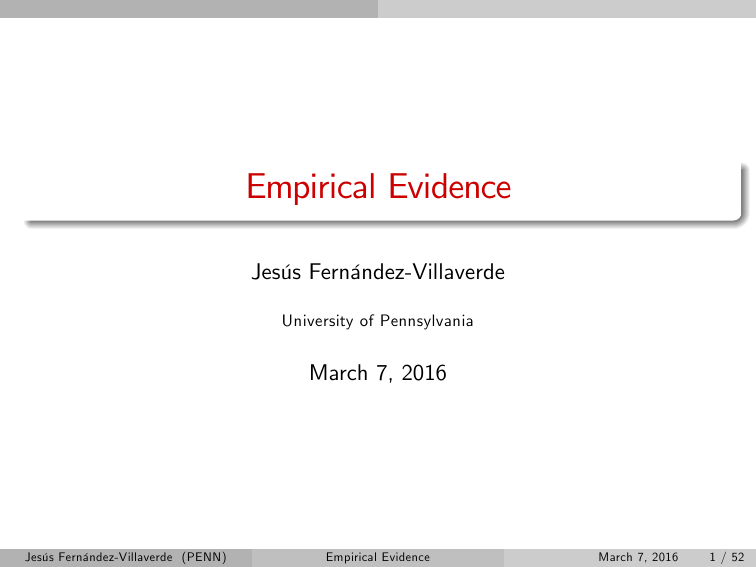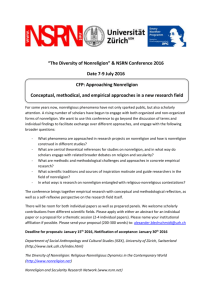Empirical Evidence Jesús Fernández-Villaverde March 7, 2016 University of Pennsylvania
advertisement

Empirical Evidence
Jesús Fernández-Villaverde
University of Pennsylvania
March 7, 2016
Jesús Fernández-Villaverde (PENN)
Empirical Evidence
March 7, 2016
1 / 52
Jesús Fernández-Villaverde (PENN)
Empirical Evidence
March 7, 2016
2 / 52
Jesús Fernández-Villaverde (PENN)
Empirical Evidence
March 7, 2016
3 / 52
Jesús Fernández-Villaverde (PENN)
Empirical Evidence
March 7, 2016
4 / 52
Jesús Fernández-Villaverde (PENN)
Empirical Evidence
March 7, 2016
5 / 52
Jesús Fernández-Villaverde (PENN)
Empirical Evidence
March 7, 2016
6 / 52
Jesús Fernández-Villaverde (PENN)
Empirical Evidence
March 7, 2016
7 / 52
Jesús Fernández-Villaverde (PENN)
Empirical Evidence
March 7, 2016
8 / 52
A long tradition...
Applied macroeconomic is concerned with the e¤ects of shocks on
certain key variables.
Shocks have been characterized by temporary changes in the
conditional mean of stochastic processes feeding our models.
1
The RBC program analyzes the consequences of temporary changes in
the conditional mean of productivity (Kydland and Prescott, 1982).
2
Monetary models are focused on the e¤ects of temporary changes in
the conditional mean of innovations to the nominal interest rates
(Woodford, 2003, or Christiano, Eichenbaum, and Evans, 2005).
3
International devotes time to understand temporary changes in the
conditional mean of the real interest rate (Mendoza, 1991 or Neumeyer
and Perri, 2005) or the terms of trade (Mendoza, 1995).
Jesús Fernández-Villaverde (PENN)
Empirical Evidence
March 7, 2016
9 / 52
...and a continuation
More recently, applied macroeconomists have started moving their
attention towards situations where shocks are characterized by
temporary changes in the conditional second moments of the
stochastic processes.
In particular, time-varying standard deviations.
A …rst motivation for this move comes from the realization that time
series have a strong time-varying variance component.
Perhaps the most famous of those episodes was “the great
moderation” of aggregate ‡uctuations that the U.S. economy.
Jesús Fernández-Villaverde (PENN)
Empirical Evidence
March 7, 2016
10 / 52
GDP growth
Jesús Fernández-Villaverde (PENN)
Empirical Evidence
March 7, 2016
11 / 52
GDP volatility
Jesús Fernández-Villaverde (PENN)
Empirical Evidence
March 7, 2016
12 / 52
Jesús Fernández-Villaverde (PENN)
Empirical Evidence
March 7, 2016
13 / 52
GDP de‡ator
Jesús Fernández-Villaverde (PENN)
Empirical Evidence
March 7, 2016
14 / 52
GDP de‡ator volatility
Jesús Fernández-Villaverde (PENN)
Empirical Evidence
March 7, 2016
15 / 52
Jesús Fernández-Villaverde (PENN)
Empirical Evidence
March 7, 2016
16 / 52
FFR
Jesús Fernández-Villaverde (PENN)
Empirical Evidence
March 7, 2016
17 / 52
FFR volatility
Jesús Fernández-Villaverde (PENN)
Empirical Evidence
March 7, 2016
18 / 52
Jesús Fernández-Villaverde (PENN)
Empirical Evidence
March 7, 2016
19 / 52
Data
Changes in Volatility of U.S. Aggregate Variables
Means
Output
In‡ation
FFR
Growth
All sample
3.2427
3.2375
5.0157
Pre 1984.Q1
4.1082
3.6742
5.9683
After 1984.Q1
2.2488
2.7359
4.1449
Post-1984.Q1/pre-1984.Q1 0.5474
0.7446
0.6945
Jesús Fernández-Villaverde (PENN)
Empirical Evidence
March 7, 2016
20 / 52
Data
Changes in Volatility of U.S. Aggregate Variables
Standard Deviations
Output
In‡ation
FFR
Growth
All sample
2.6360
3.9327
3.5662
Pre 1984.Q1
3.2440
4.8338
3.8809
After 1984.Q1
1.016
2.4561
3.0128
Post-1984.Q1/pre-1984.Q1 0.3130
0.5081
0.7763
Jesús Fernández-Villaverde (PENN)
Empirical Evidence
March 7, 2016
21 / 52
Jesús Fernández-Villaverde (PENN)
Empirical Evidence
March 7, 2016
22 / 52
Interest rates
Jesús Fernández-Villaverde (PENN)
Empirical Evidence
March 7, 2016
23 / 52
Stochastic volatility I
Stochastic volatility:
xt = ρxt
1
+ σ t εt , εt
N (0, 1).
and
log σt = (1
ρσ ) log σ + ρσ log σt
1
+ 1
ρ2σ
1
2
ηut , ut
N (0, 1).
This can be a process for many observable xt : productivity, taxes,
asset returns.
Level innovations vs. volatility innovations.
Interpretation.
Non-linear structure.
Discrete time process. Alternative with di¤usion processes in
continuous time.
Jesús Fernández-Villaverde (PENN)
Empirical Evidence
March 7, 2016
24 / 52
Stochastic volatility II
Richer speci…cations:
1
More lags and moving average components.
2
Additional regressors.
3
VAR(MA)-SV.
4
Non-Gaussian innovations.
5
Correlation among innovations.
6
Threshold e¤ects.
7
Asymmetries.
Jesús Fernández-Villaverde (PENN)
Empirical Evidence
March 7, 2016
25 / 52
Other speci…cations I
Markov-regime switching models:
σt 2 [σ1 , ..., σn ]
with transition matrix
2
p11
6 ..
Pij = 4 .
pn1
...
...
3
p1n
.. 7
. 5
pnn
Advantages and disadvantages (econometric and theoretical).
Mixed-models.
Jesús Fernández-Villaverde (PENN)
Empirical Evidence
March 7, 2016
26 / 52
Other speci…cations II
GARCH(p,q):
xt = ρxt
1
+ at
where
at = σ t ε t , ε t
and
σt =
s
N (0, 1)
p
ω + ∑ αi at2
i =1
q
i
+ ∑ βi σ2t
i
i =1
Advantages and disadvantages (econometric and theoretical).
Dozens of possible variations.
Jesús Fernández-Villaverde (PENN)
Empirical Evidence
March 7, 2016
27 / 52
A real life example
Decomposition of interest rates:
rt = |{z}
r +
mean
εtb,t and εr ,t follow:
+
εtb,t
|{z}
T-Bill shocks
εr ,t
|{z}
Spread shocks
εtb,t = ρtb εtb,t
1
+ e σtb,t utb,t , utb,t
εr ,t = ρr εr ,t
1
+ e σr ,t ur ,t , ur ,t
N (0, 1)
N (0, 1)
σtb,t and σr ,t follow:
σtb,t = 1
ρσtb σtb + ρσtb σtb,t
σr ,t = 1
Jesús Fernández-Villaverde (PENN)
ρσr σr + ρσr σr ,t
1
1
+ η tb uσtb ,t , uσtb ,t
+ η r uσr ,t , uσr ,t
Empirical Evidence
N (0, 1)
N (0, 1)
March 7, 2016
28 / 52
An alternative motivation
A second motivation for this move is that temporary changes in the
conditional standard deviation of shocks can capture the spreading
out of distributions of events in the future.
For example, an increase in the variance of future paths of …scal
policy can be captured by a temporary increase in the standard
deviation of the innovations to some …scal policy rules.
Similarly, the higher volatility of sovereign debt markets as the one
currently observed can be included in our models as a temporary
increase in the standard deviation in the innovations to a
country-speci…c spread.
Jesús Fernández-Villaverde (PENN)
Empirical Evidence
March 7, 2016
29 / 52
Jesús Fernández-Villaverde (PENN)
Empirical Evidence
March 7, 2016
30 / 52
Jesús Fernández-Villaverde (PENN)
Empirical Evidence
March 7, 2016
31 / 52
Jesús Fernández-Villaverde (PENN)
Empirical Evidence
March 7, 2016
32 / 52
Jesús Fernández-Villaverde (PENN)
Empirical Evidence
March 7, 2016
33 / 52
Jesús Fernández-Villaverde (PENN)
Empirical Evidence
March 7, 2016
34 / 52
Jesús Fernández-Villaverde (PENN)
Empirical Evidence
March 7, 2016
35 / 52
Jesús Fernández-Villaverde (PENN)
Empirical Evidence
March 7, 2016
36 / 52
Jesús Fernández-Villaverde (PENN)
Empirical Evidence
March 7, 2016
37 / 52
Jesús Fernández-Villaverde (PENN)
Empirical Evidence
March 7, 2016
38 / 52
Jesús Fernández-Villaverde (PENN)
Empirical Evidence
March 7, 2016
39 / 52
Jesús Fernández-Villaverde (PENN)
Empirical Evidence
March 7, 2016
40 / 52
Jesús Fernández-Villaverde (PENN)
Empirical Evidence
March 7, 2016
41 / 52
Literature I
In one form or another, economists have talked for a long time about
time-varying volatility.
A breakthrough came with Engle’s (1982) paper on autoregressive
conditional heteroscedasticity, or ARCH.
Engle postulated that the evolution of variance over time of time
series xt was an autoregressive process that is hit by the square of the
(scaled) innovation on the level of xt .
The application in Engle’s original paper was the estimation of an
ARCH process for British in‡ation.
Early indication that this was a central issue in macroeconomics.
But it was not in macro where ARCH models came to reign: the true
boom was in …nance.
Jesús Fernández-Villaverde (PENN)
Empirical Evidence
March 7, 2016
42 / 52
Jesús Fernández-Villaverde (PENN)
Empirical Evidence
March 7, 2016
43 / 52
Literature II
The situation changed after Kim and Nelson (1998), McConnell and
Pérez-Quirós (2000), and Blanchard and Simon (2001).
Documented that the volatility of U.S. aggregate ‡uctuations had
changed over time. Stock and Watson (2002) named this
phenomenon “the great moderation.”
Sims and Zha (2006) estimated a structural vector autoregression
(SVAR) with Markov-regime switching both in the autoregressive
coe¢ cients and in the variances of the disturbances.
They concluded that models with shocks that have time-varying
volatilities are a key in applied macroeconomics.
Jesús Fernández-Villaverde (PENN)
Empirical Evidence
March 7, 2016
44 / 52
Literature III
Big boom, however, is after Bloom (2009).
Many papers after it (including mine!).
We will discuss some of them as we go along.
There are:
1
Methodological issues (solution, estimation).
2
Data.
3
Conceptual: endogenous vs. exogenous uncertainty, beliefs vs. DGP.
4
Economic intuition.
Jesús Fernández-Villaverde (PENN)
Empirical Evidence
March 7, 2016
45 / 52
Mechanisms behind uncertainty shocks
1
Utility function.
2
Price decisions.
3
Oi-Hartman-Abel e¤ect.
4
Option value e¤ect.
5
Ss-rules.
6
Non-conventional preferences, Gilboa and Schmeidler (1989).
Jesús Fernández-Villaverde (PENN)
Empirical Evidence
March 7, 2016
46 / 52
Jesús Fernández-Villaverde (PENN)
Empirical Evidence
March 7, 2016
47 / 52
Oi-Hartman-Abel e¤ect
Oi (1961), Hartman (1972) and Abel (1983).
A higher variance of productivity increases investment, hiring, and
output because the optimal capital and labor choices are convex in
productivity.
Example:
y = Ak α l β
where α + β < 1.
Then:
Jesús Fernández-Villaverde (PENN)
k
= µ1 A 1
l
= µ2 A 1
Empirical Evidence
1
α β
1
α β
March 7, 2016
48 / 52
Jesús Fernández-Villaverde (PENN)
Empirical Evidence
March 7, 2016
49 / 52
Jesús Fernández-Villaverde (PENN)
Empirical Evidence
March 7, 2016
50 / 52
Jesús Fernández-Villaverde (PENN)
Empirical Evidence
March 7, 2016
51 / 52
Ambiguity aversion
Agents do not know dispersion of shocks.
Problem:
"
V (k, z ) = max0 u (ct , lt ) + β
c ,l ,k
s.t. c + k 0 = e z k α l 1
min
λ2[σt ,σt ]
α
+ (1
z = λz + σt ε0
0
Ek .z V k , z
0
#
δ )k
0
Intuition.
Jesús Fernández-Villaverde (PENN)
Empirical Evidence
March 7, 2016
52 / 52



